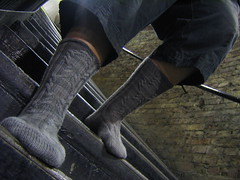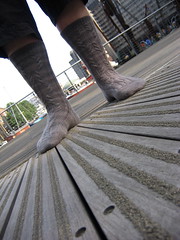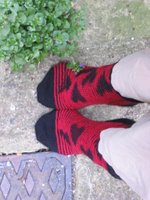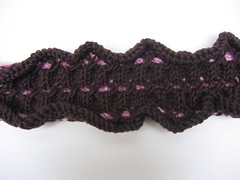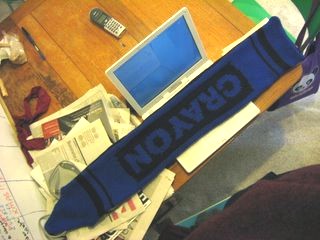
Finished this for a xmas present for my littler brother. It was inspired by a novelty plaster (plasters are bandaids - for the non-Brits). I want to make a whole set of them now. Maybe even a pencil to go with them too...
Its a bit short as a scarf for my tastes but it's backed with fleece which makes it super-warm so you don't need to double it round your neck and goes once-round quite neatly. Also, because its backed with fleece you can wear it with the plain black showing (rather than just busting the whole "my sister knitted me a novelty intarsia thing for xmas" look...)
Materials:
- 2 balls MC and I CC (both Patons Gold DK - though my gage was a little loose and I'd maybe try aran weight if I did it again)
- 1 pair 4.5mm needles
- 1 tapestry needle
- Set of bobbins
- Also, to back, you'll need about 1m by 20cm of black fleece (this is generous, but should do it, I suggest you knit then measure before you buy), a normal sewing needle and some black cotton thread.
Gage and measurements:
17sts and 23rows to 10cm x 10cm square in st st. Note my knitting is very loose so you should check your gage first, you might want larger needles. It’s worth matching gage because proportions are everything in this. If it’s too tight, it’ll not only be a bit “skinny” for a scarf, but pretty short too. The whole thing measured nearly 1m.
Instructions
Its stocking stitch throughout.
CO 10 sts, and m1 at the end of each row till you have 22sts. Knit in st st till it measures about 11cm. CO 4 sts at the end of each row (so you now have 30 sts in total) and knit for another 5cm.
Swap to CC, and knit 6rows, then 4rows MC, 2 rows CC.
Knit 20rows CC.
*K11 CC, change to CC, k8, swap back to CC and knit to end.
P8 CC, p14 MC, p8 CC
K5 CC, k20 MC, k5 CC
P5 CC, p20 MC, p5 CC
K5 CC, k20 MC, k5 CC*
Now pause to draw yourself out a chart for the label. I'd pass on mine but its paper and covered in scribbles, its easy enough to do your own. You might want to change the shape at the ends of the label, I'm not sure about mine. I used the letter grid from Magknits' Crime of Fashion scarf. The letters are the MC (in my case blue) with a CC (black) boarder of four sts either side. there will be 5 MC either side of that. Which means at times you'll have up to seven bobbins going at once.
Don't be tempted to faire-isle it, it'll go all lumpy. Also, remember you're working from the "N" up (or "A" if your going to make it say crayola).
Knit and purl and bobbin away till you've got to the end. repeat the section * to * but back to front (so it mirrors the start.
Knit 20 rows in MC, 2rows CC, 4rows MC, 6 rows CC, 14 rows MC.
Cast off, weave in ends, go to your friendly local fabric shop for some black fleece to back it with.

